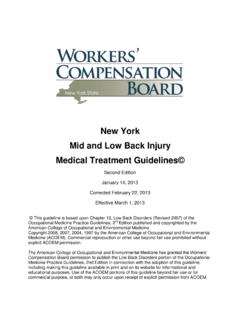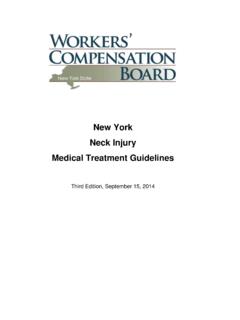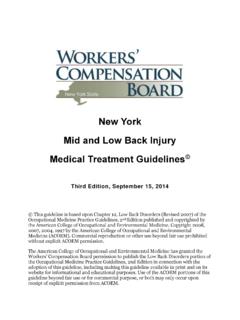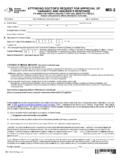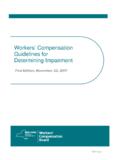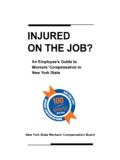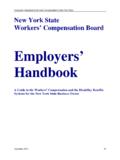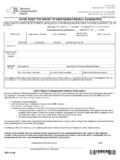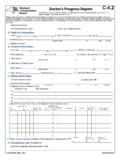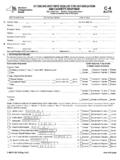Transcription of New York Shoulder Injury Medical Treatment Guidelines
1 New york Shoulder Injury Medical Treatment Guidelines Third edition , September 15, 2014 New york State Workers Compensation Board New york Shoulder Injury Medical Treatment Guidelines Third edition , September 15, 2014 i TABLE OF CONTENTS GENERAL GUIDELINE PRINCIPLES .. 1 Medical CARE .. 1 RENDERING OF Medical SERVICES .. 1 POSITIVE PATIENT RESPONSE .. 1 RE-EVALUATE Treatment .. 1 EDUCATION .. 2 DIAGNOSTIC TIME 2 Treatment TIME FRAMES .. 2 DELAYED RECOVERY .. 2 ACTIVE INTERVENTIONS .. 3 ACTIVE THERAPEUTIC EXERCISE PROGRAM .. 3 DIAGNOSTIC IMAGING AND TESTING PROCEDURES .. 3 SURGICAL INTERVENTIONS .. 4 PRE-AUTHORIZATION .. 4 PERSONALITY/PSYCHOLOGICAL/PSYCHOSOCIAL EVALUATIONS .. 4 PERSONALITY/PSYCHOLOGICAL/PSYCHOSOCIAL INTERVENTION .. 5 FUNCTIONAL CAPACITY EVALUATION (FCE) .. 5 RETURN TO WORK .. 6 JOB SITE EVALUATION .. 6 GUIDELINE RECOMMENDATIONS AND Medical EVIDENCE.
2 7 EXPERIMENTAL/INVESTIGATIONAL Treatment .. 7 INJURED WORKERS AS PATIENTS .. 7 SCOPE OF PRACTICE .. 7 INTRODUCTION TO Shoulder Injury .. 8 HISTORY TAKING AND PHYSICAL EXAMINATION .. 10 HISTORY TAKING .. 10 PHYSICAL FINDINGS .. 10 New york State Workers Compensation Board New york Shoulder Injury Medical Treatment Guidelines Third edition , September 15, 2014 ii RED FLAGS .. 10 FOLLOW-UP DIAGNOSTIC IMAGING/TESTING .. 10 SPECIFIC DIAGNOSES, TESTING AND Treatment PROCEDURES .. 11 ACROMIOCLAVICULAR (AC) JOINT SPRAINS/ DISLOCATIONS .. 11 History and Mechanism of Injury (AC Joint Sprains/Dislocations) .. 13 Physical Findings (AC Joint Sprains/Dislocations) .. 13 Laboratory Tests (AC Joint Sprains/Dislocations) .. 13 Testing Procedures (AC Joint Sprains/Dislocations) .. 13 Non-Operative Treatment Procedures (AC Joint Sprains/Dislocations) .. 13 Operative Procedures (AC Joint Sprains/Dislocations).
3 14 Post-Operative Procedures (AC Joint Sprains/Dislocations) ..14 ADHESIVE CAPSULITIS/FROZEN Shoulder DISORDER .. 15 History and Mechanism of Injury (Adhesive Capsulitis/Frozen Shoulder ) .. 15 Physical Findings (Adhesive Capsulitis/Frozen Shoulder ) .. 15 Laboratory Tests (Adhesive Capsulitis/Frozen Shoulder ) .. 15 Testing Procedures (Adhesive Capsulitis/Frozen Shoulder ) .. 16 Non-Operative Treatment Procedures (Adhesive Capsulitis/Frozen Shoulder ) .. 16 Operative Procedures (Adhesive Capsulitis/Frozen Shoulder ) .. 17 Post-Operative Procedures (Adhesive Capsulitis/Frozen Shoulder ) .. 18 BICIPITAL TENDON DISORDERS .. 18 History and Mechanism of Injury (Bicipital Tendon Disorders) .. 18 Physical Findings (Bicipital Tendon Disorders) .. 19 Laboratory Tests (Bicipital Tendon Disorders) .. 19 Testing Procedures (Bicipital Tendon Disorders) .. 20 Non-Operative Treatment Procedures (Bicipital Tendon Disorders).
4 20 Operative Procedures (Bicipital Tendon Disorders) ..21 Post-Operative Procedures (Bicipital Tendon Disorders) ..21 BRACHIOPLEXUS 21 Brachial Plexus .. 22 New york State Workers Compensation Board New york Shoulder Injury Medical Treatment Guidelines Third edition , September 15, 2014 iii Axillary 24 Long Thoracic Nerve .. 25 Musculocutaneous Nerve .. 26 Spinal Accessory Nerve .. 28 Suprascapular Nerve .. 29 BURSITIS OF THE Shoulder .. 30 History and Mechanism of Injury (Bursitis of the Shoulder ) .. 30 Physical Findings (Bursitis of the Shoulder ) .. 31 Laboratory Tests (Bursitis of the Shoulder ) .. 31 Testing Procedures (Bursitis of the Shoulder ) .. 31 Non-Operative Treatment Procedures (Bursitis of the Shoulder ) .. 31 Operative Procedures (Bursitis of the Shoulder ) .. 32 IMPINGEMENT SYNDROME .. 32 History and Mechanism of Injury (Impingement Syndrome) .. 33 Physical Findings (Impingement Syndrome).
5 33 Laboratory Tests (Impingement Syndrome) .. 34 Testing Procedures (Impingement Syndrome) .. 34 Non-Operative Treatment Procedures (Impingement Syndrome) .. 34 Operative Procedures (Impingement Syndrome) .. 35 Post-Operative Procedures (Impingement Syndrome) .. 36 ROTATOR CUFF TEARS .. 36 History and Mechanism of Injury (Rotator Cuff Tear) .. 36 Physical Findings (Rotator Cuff Tear) .. 37 Laboratory Tests (Rotator Cuff Tear) .. 37 Testing Procedures (Rotator Cuff Tear) .. 38 Non-Operative Treatment Procedures (Rotator Cuff Tear) .. 38 Operative Procedures (Rotator Cuff Tear) .. 39 Post-Operative Procedures (Rotator Cuff Tear) .. 40 ROTATOR CUFF TENDINITIS .. 41 History and Mechanism of Injury (Rotator Cuff Tendinitis) ..41 Physical Findings (Rotator Cuff Tendinitis)..41 New york State Workers Compensation Board New york Shoulder Injury Medical Treatment Guidelines Third edition , September 15, 2014 iv Laboratory Tests (Rotator Cuff Tendinitis).
6 41 Testing Procedures (Rotator Cuff Tendinitis) ..41 Non-Operative Treatment Procedures (Rotator Cuff Tendinitis) .. 42 Operative Procedures (Rotator Cuff Tendinitis) .. 42 Shoulder FRACTURES .. 42 Clavicular Fracture .. 42 Proximal Humeral Fracture .. 44 Humeral Shaft Fracture .. 46 Scapular Fracture .. 48 Sternoclavicular Dislocation/Fracture .. 50 Shoulder INSTABILITY .. 52 History and Mechanism of Injury ( Shoulder Instability) .. 52 Physical Findings ( Shoulder Instability) .. 52 Laboratory Tests ( Shoulder Instability) .. 53 Testing Procedures ( Shoulder Instability) .. 53 Non-Operative Treatment Procedures ( Shoulder Instability) .. 53 Operative Procedures ( Shoulder Instability) .. 55 Post-Operative Procedures ( Shoulder Instability) .. 55 SUPERIOR LABRUM ANTERIOR AND POSTERIOR (SLAP) LESIONS .. 55 History and Mechanisms of Injury (SLAP lesion).
7 56 Physical Findings (SLAP lesion) .. 56 Diagnostic Testing Procedures (SLAP lesion) .. 57 Non-Operative Treatment Procedures (SLAP Lesion).. 58 Surgical Indications .. 59 Operative Procedures (SLAP lesion) .. 59 Post-Operative Treatment (SLAP lesion) .. 60 THERAPEUTIC PROCEDURES: NON-OPERATIVE .. 60 MEDICATIONS .. 60 Acetaminophen .. 60 Compound Medications .. 61 New york State Workers Compensation Board New york Shoulder Injury Medical Treatment Guidelines Third edition , September 15, 2014 v Hypnotics .. 61 Narcotics .. 61 Nonsteroidal Anti-Inflammatory Drugs (NSAIDs) .. 62 Psychotropic/Anti-Anxiety Medications .. 64 Skeletal Muscle Relaxants .. 64 Topical Drug Delivery .. 64 Tramadol .. 65 IMMOBILIZATION .. 66 Kinesiotaping, Taping or Strapping .. 66 RELATIVE REST .. 66 THERAPEUTIC EXERCISE .. 66 SUPERFICIAL HEAT AND COLD .. 67 TRANSCUTANEOUS ELECTRICAL NERVE STIMULATION (TENS).
8 67 THERAPEUTIC ULTRASOUND WITH OR WITHOUT ELECTRIC STIMULATION .. 68 ELECTRICAL THERAPEUTIC MODALITY .. 68 RETURN TO WORK .. 68 BIOFEEDBACK .. 68 PHYSICAL MEDICINE AND REHABILITATION .. 68 Instruction in Therapeutic Exercise and Proper Work Techniques .. 68 Manual Therapy Techniques .. 69 Post-Operative Treatment .. 69 THERAPY: ONGOING MAINTENANCE CARE .. 69 New york State Workers Compensation Board New york Shoulder Injury Medical Treatment Guidelines Third edition , September 15, 2014 1 GENERAL GUIDELINE PRINCIPLES The principles summarized in this section are key to the intended application of the New york State Medical Treatment Guidelines (MTG). Medical Care Medical CARE Medical care and Treatment required as a result of a work-related Injury should be focused on restoring functional ability required to meet the patient s daily and work activities and return to work, while striving to restore the patient s health to its pre- Injury status in so far as is feasible.
9 RENDERING OF Medical SERVICES Any Medical provider rendering services to a workers compensation patient must utilize the Treatment Guidelines as provided for with respect to all work-related injuries and/or illnesses. POSITIVE PATIENT RESPONSE Positive results are defined primarily as functional gains which can be objectively measured. Objective functional gains include, but are not limited to, positional tolerances, range of motion, strength, endurance, activities of daily living (ADL), cognition, psychological behavior, and efficiency/velocity measures which can be quantified. Subjective reports of pain and function should be considered and given relative weight when the pain has anatomic and physiologic correlation. RE-EVALUATE Treatment If a given Treatment or modality is not producing positive results, the provider should either modify or discontinue the Treatment regime. The provider should evaluate the efficacy of the Treatment or modality 2 to 3 weeks after the initial visit and 3 to 4 weeks thereafter.
10 Recognizing that Treatment failure is at times attributable to an incorrect diagnosis should prompt the clinician to reconsider the diagnosis in the event of an unexpected poor response to an otherwise rational intervention. New york State Workers Compensation Board New york Shoulder Injury Medical Treatment Guidelines Third edition , September 15, 2014 2 Education EDUCATION Education of the patient and family, as well as the employer, insurer, policy makers and the community should be a primary emphasis in the Treatment of work-related Injury or illness. Practitioners should develop and implement effective educational strategies and skills. An education-based paradigm should always start with communication providing reassuring information to the patient. No Treatment plan is complete without addressing issues of individual and/or group patient education as a means of facilitating self-management of symptoms and prevention of future Injury .
